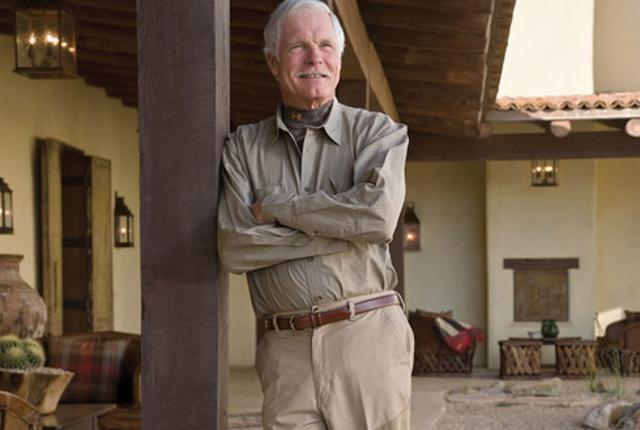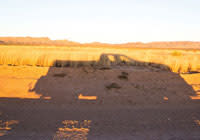 NEED TO KNOW
NEED TO KNOWTed Turner Expeditions is now offering tours on the Armendaris and Ladder ranches, with preferential access to guests of the Turner-owned Sierra Grande Lodge & Spa (575- 894-6976; sierragrandelodge.com). Accommodations are available at Turner’s house on the Ladder Ranch. Accommodations and activities are also offered at Turner’s northern New Mexico property, Vermejo Park Ranch. For current information go to tedturnerexpeditions.com.
Nearby sites and attractions that provide historical context and a view of the landscape include the ruins of Fort Craig, which occupies a 160-acre inholding on the Armendaris Ranch not far south of the Bosque del Apache. The Union Army compound was active from 1854 to 1885. Interpretive signs along paths on the site and a small visitor center provide timelines of human activity starting with the 12th century BC. The 1862 Battle of Valverde took place just north of the fort. The peaceful site is administered by the BLM and staffed by volunteers. The visitor center is closed on Tuesdays and Wednesdays. (575) 835-0412; blm.gov/nm/fortcraig
Museum displays at the nearby El Camino Real Historic Trail Site describe the history of Spanish exploration, settlement, and contact with Native peoples. The site affords a view of the Armendaris Ranch plains. Use exit 115 from I-25 (35 miles south of Socorro) to reach both Fort Craig and the Camino Real center, which is closed on Mondays and Tuesdays. (575) 854-3600; nmmonuments.org
The Geronimo Springs Museum, on Main Avenue in T or C, houses a robust collection of artifacts that illuminate regional Native, Hispanic, mining, and ranching history. Open daily. (575) 894-6600; geronimospringsmuseum.com.
While in T or C, visit the Geronimo Trail Visitor Center for information about the Geronimo Trail National Scenic Byway, which passes the southern and northern boundaries of the Ladder Ranch. This is one of the state’s most beautiful and interesting drives. (575) 894-1968; geronimotrail.com
Right after you go past the Bosque del Apache while driving down I-25, you cut through a corner of the Armendaris Ranch. Soon you come up along-side some muscular brown mountains that stretch for the next 27 miles and loom over Elephant Butte Lake. That’s the Fra Cristobal Range, and it’s all part of the Armendaris, too. Ted Turner owns the ranch, and his house is on the other side of the mountains. The view from there is of a vast sea of high-desert grassland that washes up to distant mountain shores, and Turner owns almost all of that as well.
After another 20 minutes or so of driving, you cast your gaze in the other direction, to the southwest. Most of the land from here to the Black Range is part of the Ladder Ranch, also owned by Turner. By the time you get to the turnoff for Caballo Lake and scenic Highway 152, you’ve been driving through Turner country for the last 60 miles.
You backtrack to Truth or Consequences, the town that lies between the two ranches, and check in to the best hotel around, the Sierra Grande. Turner has owned it since 2013. You settle in to your room and peruse the menu of television stations. Among the options are TBS, CNN, and TNT—all started by Turner. When it’s time to eat, you go downstairs to the new restaurant and order a bison burger. The meat was raised on one of Turner’s 15 ranches, maybe even one of the ones you just drove past.
Most of us travel this well-worn stretch of highway without realizing that we’re practically trespassing on land owned by Ted Turner. Sure, we’re probably aware that Turner is the number-one landowner in this state—the Vermejo Ranch in northern New Mexico is the single biggest piece of private property in the whole country—but it’s vague, because all of it’s a rich man’s domain that we just don’t know much about. Besides, he’s more popularly associated with the Southeast and the northern Rockies. But now Turner is swinging open the metal gates to his southern New Mexico ranches by offering eco-tours that originate at the Sierra Grande. He says it’s a business he’s been thinking about getting into, and he calls it an experiment at this point, but you’ve got to admit: The man has a pretty good track record. He captained a sailboat that won the America’s Cup. He owned a baseball team that won the World Series. He basically invented the cable industry and shaped the television landscape we lived in for the final decades of the 20th century. Along the way, he amassed a fortune that enabled him to donate a billion dollars to pick up the country’s tab at the United Nations. True, the AOL Time Warner Turner merger didn’t work out so well—he bled $10 million a day for two years—but his net worth stabilized at $2 billion, and he’s not complaining. Turner is quite likely the world’s foremost capitalist conservationist—his empire’s audacious motto is “Save Everything”—and what happens on the ranches he owns in New Mexico is a big part of that agenda.
So when Ted Turner invites you to look around his ranches, you go. “We’ll just show the people what they want to see,” he says.
Don Diego de Vargas, the Spanish governor who came up the Camino Real de Tierra Adentro from Mexico City to Santa Fe, wasn’t such a big fan of the terrain. “I have exiled myself to this kingdom at the ends of the earth and remote beyond compare,” he wrote in 1692. Not for nothing was a 42-mile stretch of the Camino that goes through the Armendaris called the Jornada del Muerto—the Dead Man’s Journey.
The neighboring White Sands Missile Range and Spaceport America are both out here for a reason—to the naked eye, there’s just not much to see. The Río Grande and Elephant Butte Lake provide the Armendaris with some shoreline, and the Fra Cristo-bals foster an inland island habitat, but most of the 550-square-mile ranch is flat and full of cholla cactus, sage scrub, mesquite, and black grama grass. The northern reach of the Chihuahuan Desert, it gets a meager 8.5 inches of rain a year, and no doubt it’s tough country that’s probably not for everyone. “It’s kind of different out here,” says ranch manager Tom Waddell, “but it grows on you. Ted really likes this ranch for some reason.”
“I just think it’s beautiful,” says Turner.
When he bought the Armendaris in 1994, Turner and then-wife Jane Fonda and their family put up in a funky old bunkhouse before building the handsome 6,000-square-foot adobe lodge-style house he stays in the 20 or so days a year he spends in southern New Mexico. The house is the “ultimate man cave,” says Waddell, and it contains museum-quality displays of Native pottery, basketry, rugs, and Western art. But on a master-of-the-universe scale, it’s merely grand, not grandiose, and the shampoo in the master bath is Prell. “Ted’s not a fancy person,” says Waddell. It’s really all about the land and what lives on it.
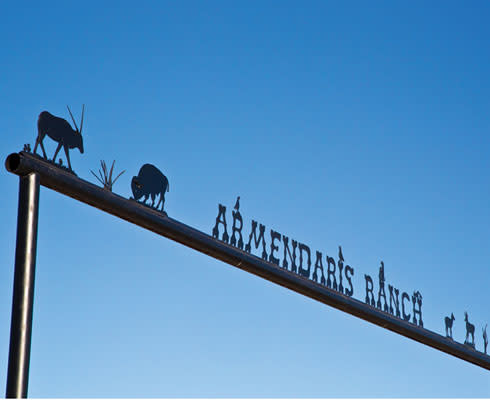 (photo Kevin Garrett)
(photo Kevin Garrett)
It’s true: The wildly colorful story of the Southwest is written in this sere landscape, starting with prehistory. A former seafloor, it bears evidence of coral reefs, Cretaceous Period fossils including recently discovered triceratops bones, a petrified tree trunk that’s six feet wide and 70 feet long, and Clovis and Folsom sites that divulge arrowhead points from 14,000 years ago. Apache came through in the 1500s, then the Spanish explorers, and later ranching settlers and the railroad that serviced them. There are important Indian War and Civil War sites (Fort Craig is an inholding), and no shortage of Cold War artifacts. Seven towns came and went on the property, and Pedro Armendaris established the ranch with a Spanish land grant in 1819. He is said to have chosen it because he thought it had the best grass between Mexico City and Santa Fe. An 1845 map shows the ranch as the westernmost outpost of the Republic of Texas.“I’ve been all over the world,” says the 77-year-old Turner, sitting for an interview in the Sierra Grande Spa. “I’ve been to the rainforest, and the Serengeti in Tanzania, I’ve been to the Arctic and Antarctica, I’ve seen polar bears and killer whales—and down here is really terrific for wildlife and from a historic standpoint.”
Turner’s post-sailing, post-baseball sporting passion is quail hunting, and the ranches are managed to support the birds. “It’s challenging hunting,” he says, what with all the rocks and cactus to negotiate on foot, but Waddell says the boss is “deadly accurate” with his .410 shotgun. The loftier land-management agenda, says Turner, is to “make the environment as similar as possible to what it was when the conquistadors arrived.”
 (photo Kevin Garrett)
(photo Kevin Garrett)
His signature effort to that end is bison ranching. An estimated 30 million buffalo populated the Great Plains before the Europeans arrived, but by the end of the 19th century there were fewer than 2,000. Eradicating them was a strategy for starving Native Americans of their food. Today, Turner raises some 52,000 of them on his various ranches. “That’s 20 percent of all the bison in the United States,” he says. He considers this an example of how he’s been able to help reverse a world-historic environmental disaster. And because the meat is served in his chain of Ted’s Montana Grills, the animals pay for themselves. Turner may be a whale of a philanthropist, but this isn’t a charity: His ranches are supposed to run solvent. About a thousand bison roam the Armendaris, but since they’re allocated 125 acres per cow and calf, it can take an hour of driving to find a group of around 50. When you do, on land that shows little evidence of human intervention, it’s a primal Western scene to behold. They may be managed like livestock, but they’re wild animals, “somewhere between an African buffalo and cattle,” says Waddell, noting that bison and cattle differ in DNA by 10 percent. “We’re closer to being a monkey than a bison is to being a cow.”
 A group of oryx—normally seen only in Africa—lopes across the Armendaris plains.
A group of oryx—normally seen only in Africa—lopes across the Armendaris plains.
(courtesy Ted Turner)
“We’ll go find a herd of oryx now,” says Waddell, and those are words you won’t hear in North America outside of New Mexico. The desert-adapted African antelope migrated into the ranch from White Sands Missile Range, where they’d been introduced as sporting game for military personnel. Coming upon a small group of the couple hundred animals that live on the ranch, you get a quick chance at a photo as they gracefully take off through the scrub. Weighing up to 500 pounds, they're among the larger antelopes, and with their straight 40-inch horns, distinctive black-and-white face masks and laeggings, and muscular taupe haunches, they're some of the best-looking ones, too.
Between what wildlife people like to call “charismatic megafauna” and Waddell’s knowledgeable interpretation of what you’re seeing, you might feel like you’ve been zapped to a safari in the Kalahari Desert. This is precisely the rationale behind both hunting and eco-tourism on the ranches. Turner Ranch Outfitting sells 50 oryx tags a year here, for game management and revenues. Elsewhere on the Armendaris, there’s a cave in a lava flow that’s home to the country’s third-biggest flight of bats. Depending on the season, up to five million of them emerge at dusk in an hour-long spectacle that attracts local hawks to dive-bomb the bats. The thinking is that certain nature lovers would pay to see that.
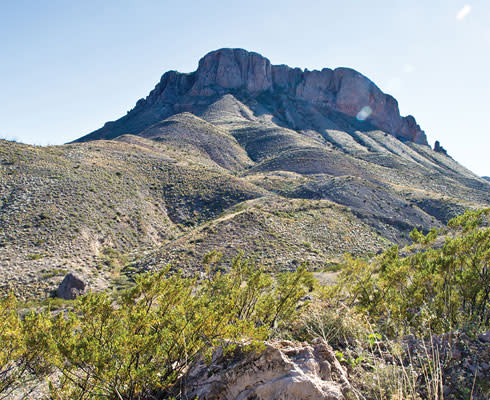 The Fra Cristobal Range on the Armendaris Ranch.
The Fra Cristobal Range on the Armendaris Ranch.
(photo Kevin Garrett)
The introduction of desert bighorn sheep to the Fra Cristobals is another success story that’s dear to Turner. “The state supplied us with 30 of them, and now we have over 300,” he says. “The state’s tickled, and we’re tickled that they’ve taken them off the endangered species list, and that’s allowed limited hunting of the excess rams.” Six tags a year are sold for $75,000 apiece. (“That’s a little cheap,” says Waddell. “We think they’re worth a hundred.”) Other game species that are earning the right and paying the price to roam the Armendaris include pronghorn, elk, and mule deer. There are even some mountain lions moving in and out of the Fra Cristobals, attracted by the sheep. Nobody’s hunting them, and your chances of spotting them are minuscule, but it’s nice to know they’re there. It means the place is wild, the way it was before the Spaniards established the first mines in North America in these very mountains, before the Apache used them as a redoubt in the Indian Wars. It means things are just the way Turner wants them to be. “Ted likes sheep, the guests like sheep, and they’re a good income,” says Waddell.
 On the Ladder Ranch, “You might see elk or a bear while you’re out quail hunting,” says ranch manager Steve Dobrott.
On the Ladder Ranch, “You might see elk or a bear while you’re out quail hunting,” says ranch manager Steve Dobrott.
(photo Kevin Garrett)
The Ladder Ranch could be forgiven for considering itself the fairer of Turner’s southern New Mexico sibling ranches. It's greener because there's more water, its canyon-and-mesa topography pleases the eye with its vertical variety, and there's an 1890s-era ranch settlement—including Turner’s house and a cowboy bunkhouse—that looks like a set for a Western. In the eco-tourism program, the residences are being made available to guests, complete with retro décor selected by Jane Fonda.
“The Ladder is in the foothills of the Black Range,” says Turner, referring to the mountains that form the eastern ridge of the Gila Wilderness, the largest piece of wildland in the Lower 48. “It goes from 5,000 feet to 8,000 feet—that’s almost a mile of habitat changes—and there are four or five streams that run down from the mountains.”
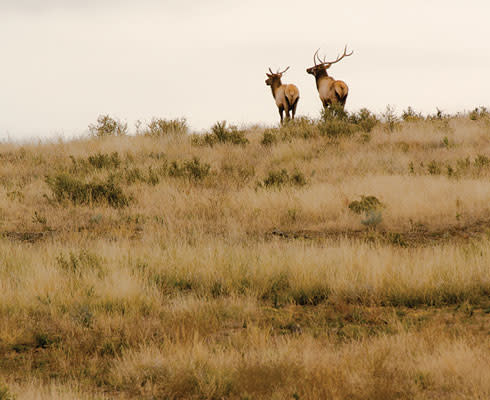 Elk on the Ladder Ranch.
Elk on the Ladder Ranch.
(photo Kevin Garrett)
The property—157,041 deeded acres, and another 100,636 under lease—represents the intersection of, and transition between, the lower Rockies and the southern desert. Ranch manager Steve Dobrott has called it “the finest example of wildlife diversity in the state ... a wildlife biologist’s dream world.” Which is nice for him, because he’s an endangered species biologist who’s been taking care of the place since Turner bought it in 1992. There are 500 miles of road on the ranch, and the crew has removed 250 miles of cattle fencing to allow wildlife free rein. Some 1,300 bison live here, as do elk, pronghorn, deer, turkeys, and bears. There are 12th-century Mimbres sites, vivid petroglyphs by Apache and Spaniards, Indian War battle sites, and mining-era ghost towns. Now there’s a media-turned-bison mogul who owns the place and wants to use it to help save the world. Again, the story of the Southwest could be told in microcosm on this very ranch.
And like the Armendaris, a lot of the place’s appeal for Turner is quail, three species of which are found here (Gambel’s, scaled, and Montezuma). He’ll often come over here for a day of hunting, use the main house as his lunch spot, and return to the Armendaris. But quail aren’t the only notable birds hereabouts. Thanks to all the water that flows through the ranch from the Black Range toward the Río Grande, the area attracts migratory neo-tropical species from Mexico and South America.
“Jimmy Carter is a friend of mine,” says Turner, “and when I first bought the Ladder Ranch, he’d gotten into bird-watching. He said, ‘I’d like to go out and look for birds on your ranch,’ and I said, ‘Let’s do it.’ An Audubon Society expert came with us, and in three days we saw 101 species of birds. Twenty-one of them were lifers for Carter, everything from roadrunners to vermillion flycatchers.” Dobrott says the ranch’s bird list is 252 species.
Turner’s ranches are considered eco-labs, and on the Ladder there’s a Mexican gray wolf recovery project as well as a Bolson tortoise reintroduction project (they’re endangered in Mexico), and Chiricahua leopard frogs have been resuscitated. “The Ladder has the most biodiversity in the Turner portfolio,” says Dobrott. “Ted’s philosophy is that the animals have as much a right to be here as we do.” That extends even to rattlesnakes, which are relocated rather than killed when they come around headquarters.
Biology, history, bird-watching, game viewing, photography, hiking—no shortage of stuff to do and learn on the Ladder. “Ted is eager to share it with the public,” says Dobrott.
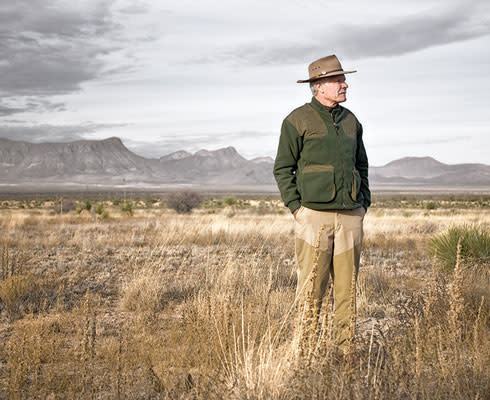
Turner is the second-largest landowner in the country after John Malone (another media mogul who owns a couple of rather impressive ranches here, the TO and the Bell). He owns over 3,000 square miles of property: Visualize a mile-wide strip of land from coast to coast. Between the Ladder and the Armendaris, 812 square miles of that land lie in southern New Mexico. The Vermejo Ranch, up north, is nearly 920 square miles. It hosts hunting and fishing expeditions, and Mike Friedman, whose Adventure Partners is developing the eco-tourism program, envisions the day when the three properties will be linked in “an overarching eco-tourism experience that links the most extensive collection of Southwest landscapes you could ever hope to visit.” He compares the Turner properties favorably to the great national parks, and says they can help New Mexico realize its potential as “a global destination for travelers who want to find the authentic American West.”
Part of the strategy is to accommodate the elite clientele that’s expected to flock to Truth or Consequences when Virgin Galactic’s space-tourism program eventually lifts off. The struggling town’s mayor pro tem, Steve Green, sees it becoming more of a regional hub. Opening the ranches, he says, is “huge for our city and Sierra County.”
The ecological implications are similarly huge. Dobrott and Waddell have already noticed that southern species like javelina have migrated north because of changes in the weather in the Chihuahuan Desert, while some endemic species have sought higher altitude in the mountains. Drought and its implications for grazing bison are part of the motivation for putting the Turner ranches to work in eco-tourism.
“The Southwest is where the impacts of global warming are being felt, the tip of the spear,” says Friedman. “Ted’s land is the center of the ecosystem, and anything landowners like him can do to preserve the environment will allow the most stressed-out part of the Southwest to tolerate climatological changes that are happening.”
Asked about his own aspirations for New Mexico, as its largest landholder, Turner avers that “it’s up to the New Mexicans,” whom he credits with historically exhibiting a “strong environmental ethic,” starting with Native Americans. “I’ve seen a good bit of the state over the 25 years I’ve had investments down here,” he says, “and it’s just a beautiful, unique place. It deserves to be taken care of.”
Dave Herndon is the editor-in-chief of New Mexico Magazine.


